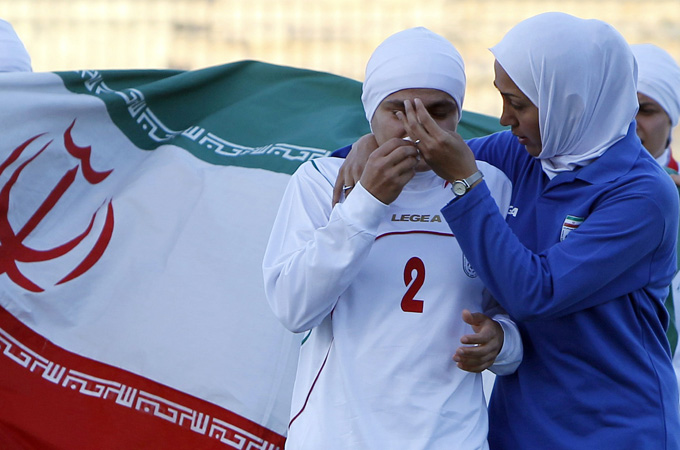The socio-politics of the Middle East
The urban youth in the Middle East region find it a daunting task to adhere to the ideologies set by Islamist movements.

 |
| Across the Middle East, resistance to conservative authoritarianism – such as women’s participation in sport – often takes on a religious element [REUTERS] |
In the past three decades, the Middle East has been the location of three successful popular revolutions, in which ordinary people successfully overthrew their governments: Iran (1979), Egypt (2011) and Tunisia (2011). Bahrain, Syria and Jordan have also been experiencing democratic uprisings and movements. However, these movements have yet to yield a change in the power structures in their countries. What are some of the reasons why these revolutionary movements were not predicted by the United States or the European Union? To understand, one must view these movements as being socio-politically and socio-religiously distinct from popular movements that have been experienced in the West.
Viewed through the prism of prevailing social movement theories, primarily developed in politically open western societies, many scholars have concluded that there are no such things as youth or women’s movements in the Middle East – because the characteristics of Middle Eastern women or youth activities do not necessarily comply with the “framework” with which Western scholars are familiar. This begs the question, to what extent can this framework account for the complexities of the socio-political and socio-religious particularities of “social movements” in the Middle East and how may it help us understand collective resistance in politically closed societies?
What comes to be known as “social movements” or “people’s movements” in politically open societies constitutes three fundamental elements: first, they have an organised and sustained claim against the authorities, second, they hold a repertoire of performances such as street marches, public meetings, associations and media statements, and third, in different political actions, they had, as Charles Tilly said, “public representations of the cause’s worthiness, unity, numbers, and commitments”.
Social movements in most Middle Eastern and Muslim societies are characterised by particular, unconventional forms of activism which have not been recognised because they do not fit into the Western conceptual imagination and do not fit into prevailing sociological categories. Under the authoritarian regimes that continue to suppress demands for the rule of law, democracy and the lifting of restrictions on opposition parties – such as those in Syria and Iran – people’s resistance movements have taken a unique socio-religious character.
Popular resistance
Such a resistance produced in such states can be characterised, as Asef Bayat puts it, as “the silent, protracted, but pervasive advancement of the ordinary people on the propertied, powerful, or the public – in order to survive and improve their lives”. This is the collective action of non-collective actors. It does not hold a leadership, fixed ideology or structured organisation. Therefore, in the Middle Eastern societies, people’s resistance to the existing social order hold three main characteristics. First, a tendency to be action-oriented and quiet. Their demands are made on an individual basis as opposed to being ideologically driven, audible and in unified groups. Second, in this kind of resistance, people, despite government sanctions, implement their claims directly – rather than being organised and mobilised under leaders. Third, the resistance takes place during the ordinary practices of everyday life, rather than through getting involved in extraordinary deeds of mobilisation such as attending meetings, lobbying, petitioning and so on.
This resistance challenges the sovereignty of the state and brings socio-political change to religion and government. The reaction of each individual to the various modes of power has created the collective resistance of non-collective actors. Furthermore, this is the logical collective reaction of individuals within a group when they are confronted by the same threat. Every individual, in spite of all odds, discovers new spaces – within which he or she can make herself realised, heard, felt and seen.
Millions of dispersed and detached individuals, who thrive to improve their lives in a lifelong collective effort, create this protracted mobilisation, which bears few elements of structured organisation, ideology or centred leadership. For instance, women strive to play sport go to college, do “men’s work”, work in public and choose their own partners. Young people struggle to wear what they like and listen to the music they wish. Furthermore, one can view the interactions, contradictions and excesses between the states and people through how Iranian women have been able to encroach upon and challenge patriarchal power – despite limited spaces and opportunities for open political activism.
Other examples include the struggle of urban youth to create a space for “fun” lifestyles and ideologies which are not approved by the state or by Islamist movements; the urban poor running their own parking services; Iranian youths throwing parties behind closed doors; the daily cosmopolitan co-existence between Muslims and Christians in an Egyptian suburb; Muslim women wearing the veil, or hijab, based on their individual preferences; Egyptian and Iranian youth expressing themselves by balancing God and fun; and the ways in which urban public spaces have transformed into locations of struggle in many parts of the Middle East.
In order to better understand and to better predict these kinds of upheavals and structural shifts in the future, it would help to understand the socio-political and socio-religious character of the ordinary’s people movements vis a vis their respective regimes in the Middle East and North Africa.
Majid Rafizadeh is an Iranian/Syrian Fulbright scholar, currently conducting research at the Woodrow Wilson International Center for Scholars. He is also columnist for the Harvard International Review.
The views expressed in this article are the author’s own and do not necessarily reflect Al Jazeera’s editorial policy.
